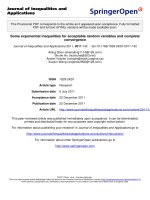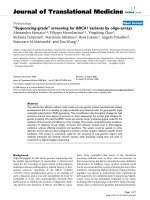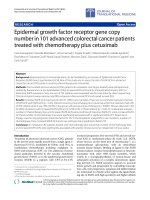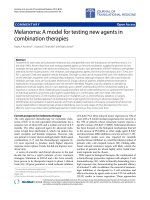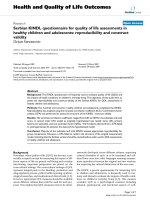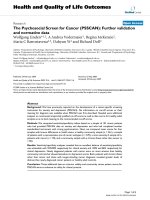Báo cáo hóa học: " Optimal Growth Conditions for Selective Ge Islands Positioning on Pit-Patterned Si(001)" ppt
Bạn đang xem bản rút gọn của tài liệu. Xem và tải ngay bản đầy đủ của tài liệu tại đây (553.49 KB, 5 trang )
SPECIAL ISSUE ARTICLE
Optimal Growth Conditions for Selective Ge Islands Positioning
on Pit-Patterned Si(001)
R. Bergamaschini
•
F. Montalenti
•
L. Miglio
Received: 29 June 2010 / Accepted: 26 July 2010 / Published online: 6 August 2010
Ó The Author(s) 2010. This article is published with open access at Springerlink.com
Abstract We investigate ordered nucleation of Ge islands
on pit-patterned Si(001) using an original hybrid Kinetic
Monte Carlo model. The method allows us to explore long
time-scale evolution while using large simulation cells. We
analyze the possibility to achieve selective nucleation and
island homogeneity as a function of the various parameters
(flux, temperature, pit period) able to influence the growth
process. The presence of an optimal condition where the
atomic diffusivity is sufficient to guarantee nucleation only
within pits, but not so large to induce significant Ostwald
ripening, is clearly demonstrated.
Keywords Stranski-Krastanow growth Á Ge Á Si Á
Patterning Á Kinetic Monte Carlo
Introduction
Ge/Si(001) is often considered as the prototypical example
of a system following the Stranski-Krastanow (SK) growth
modality. The appearance of nanometric-sized, coherent
Ge islands [1, 2] following the formation of a thin wetting
layer (WL), attracted widespread attention in view of the
possible role that islands could play in developing future-
generation devices. Two main problems were identified
soon after the first experimental evidences of islands for-
mation were reported in the literature. On a flat Si(001)
substrate, indeed, islands tend to nucleate randomly (see,
e.g., the discussion in Montalenti et al. [3]), precluding the
possibility of obtaining ordered arrays. Secondly, under a
wide range of deposition conditions, a bimodal distribution
of islands (shallow {105} pyramids and steeper, multifac-
eted domes [4, 5]) is obtained. Very interestingly, better
lateral ordering and size homogeneity can be achieved by
growing multistacked layers of Ge islands separated by Si
spacer layers (SL) [6], the key role being played by the
strain field originated by buried Ge islands at the surface of
the outermost SL [7]. Recently, the possibility of enhanc-
ing lateral ordering directly from the first layer of deposited
islands was also explored [8]. While in all the above
reported references, some degree of lateral ordering was
clearly demonstrated, much better results, both in terms of
islands positioning and of size distribution, have been
achieved by well-tuned patterning of the Si substrate. In
particular, a suitable pit-patterning produced remarkable
results under appropriate deposition conditions [9]. Highly
ordered, unimodal distributions of dome islands are visible
in the AFM images reported in Zhong and Bauer [9].
Further evidence of nice lateral ordering can be found also
in Refs. [10, 11, 12].
In this work, we further explore ordering and homoge-
neity of Ge islands grown on pit-patterned Si(001). More
specifically, we introduce an hybrid Kinetic Monte Carlo
(h-KMC) method, developed in order to expand the typical
length and time scales treatable in standard KMC, and we
analyze the dependence of ordering and homogeneity on
key parameters such as temperature, deposition flux and pit
spacing.
Model
On very general grounds, it is clear that reliable atomistic
heteroepitaxial-growth simulations could strongly help in
R. Bergamaschini (&) Á F. Montalenti Á L. Miglio
L-NESS and Materials Science Department,
University of Milano-Bicocca, Via R. Cozzi 53,
20125 Milano, Italy
e-mail:
123
Nanoscale Res Lett (2010) 5:1873–1877
DOI 10.1007/s11671-010-9723-x
restricting the parameter-space to be experimentally sam-
pled to obtain the desired result, e.g. in terms of islands
distribution, positioning, etc. This is however a daunting
task if one is willing to capture the whole atomic-scale
complexity of Ge/Si(001) growth (with this respect, we
notice that prototypical does not mean simple), including
changes in surface reconstruction [13], long-ranged elastic
fields [14], and huge spatial (experimentally determined
island volumes easily reaching 10
5
nm
3
or more, pit
extension and spacing being of the orders of hundreds of
nm [9]) and time scales (experiments being performed at
human time scales of several seconds). Despite the use of
strong simplifications, such as solid-on-solid geometries
[15] (which we shall also exploit), the gap between
experiments and theory is still large. For example, standard
KMC simulations [16, 17, 18] for growth on patterned
substrates were reported for typical simulation-cell
dimensions of 400 9 400 atomic sites or lower [19, 20]
and were restricted to very initial stages of growth, so that a
direct comparison with experiments under realistic condi-
tions was not attempted. Nevertheless, these simulations
nicely demonstrated the existence of optimal ranges of
temperature and deposition flux for obtaining homoge-
neous and laterally ordered distributions of islands. We
therefore tried to keep the essential ingredients of the above
approaches, using however a faster simulation method
allowing for a reduction in the gap between simulation and
experiments. Although details are different, our approach is
conceptually similar to the one recently proposed by Mixa
et al. [21] for simulating PbSe/PbEuTe, since it also mixes
atomistic and continuum descriptions.
In our model, the growth substrate is defined as a two-
dimensional squared lattice, with length parameter
a *4A
˚
, corresponding to the nearest neighboring distance
on (001) planes in Si. Periodic boundary conditions are
applied. On this grid, we reproduce the dynamics of single
atoms and islands, assuming as mobile species only iso-
lated atoms, in order to limit the number of possible events.
Adatoms are described as in the standard KMC: they
diffuse between nearest neighboring sites through ther-
mally activated hops, as shown in Fig. 1. The hop-diffusion
rate for an isolated adatom is determined by the Arrhenius
relation
R
dif
¼ m
0
exp À
E
S
kT
ð1Þ
where m
0
is the hopping attempt frequency (here set to the
standard value m
0
= 10
13
s
-1
), E
S
is the diffusion barrier,
k the Boltzmann constant and T the temperature. We use
E
S
= 1.1 eV, a value compatible with similar simulations
in literature [22, 23].
Adatoms aggregates of any dimension are defined as
islands, macroscopic entities with volume-dependent shape
and geometry: all the atomic motion inside an island is
ignored assuming quick rearrangement processes to the
mean equilibrium shape. An island nucleates once two
adatoms reach the same lattice site forming a dimer and
grows capturing adatoms diffused at its perimeter or
directly deposited over its area. Coalescence between
neighboring islands is possible too. Atomic detachment
from islands is supposed to involve only atoms placed
along the perimeter (as in Ross et al. [24]) through a
thermally activated process whose barrier is assumed to be
equal to the energy of an atom inside the island. Such
quantity includes a chemical bonding contribution and an
elastic and surface energy term. The former is taken equal
to the interaction of an atom with the substrate E
S
and with
its m nearest neighbors E
nn
. The latter should require in
principle to solve the full elastic problem at each volume
and configuration but, for the sake of simplicity, it is
included in our model in an effective way as a chemical
potential term l(V). The effective detachment rate R
det
for
an island of volume V is then expressed as
R
det
¼ N
p
ðVÞm
0
exp À
E
S
þ mE
nn
À lðVÞ
kT
ð2Þ
where N
p
is the number of atoms along the island perim-
eter. More specifically, we assume that each atom on the
perimeter is bonded to three neighbors (m = 3, except for
dimers and trimers) and for each bond we define an energy
of E
nn
= 0.25 eV (again, a common value from literature
[22, 23]). Atoms removed from an island are placed in a
E
S
lattice site
(a)
3E -µ
(V)
nn
E
S
E
P
3E -µ
(V)
nn
(b)
Fig. 1 Schematic representation of the potential energy profile for
adatom diffusion and detachment from islands on flat regions (a) and
inside pits (b)
1874 Nanoscale Res Lett (2010) 5:1873–1877
123
randomly chosen adjacent site and then treated as free
adatoms. Since all events associated with islands only
involve their base, the whole dynamics can be reduced to
the growth plane, limiting the description to two dimen-
sions. As a first approximation, we consider the mean
island base as circular, with radius related to its volume.
We distinguish between three typologies of structures:
small 2D aggregates, {105} pyramids and domes. In the
case of small atomic aggregates, for which it is not proper
to consider a three-dimensional structure, we set l(V) = 0
and assimilate them to cylinders one layer high, and
perimeter determined by imposing conservation of the
total atomic volume (sum of the atomic volumes of the
atoms composing the 2D aggregate). For size greater than
3nm
3
, instead, we consider 3D islands. This magic value
is simply determined by geometrical constraints (a {105}
pyramid higher than a single (001) layer cannot occupy a
smaller volume). Following the theoretical results repor-
ted in Brehm et al. [25], pyramids are transformed into
domes when a critical volume of 2,400 nm
3
is reached, so
that the transformation into a steeper morphology is
energetically favored. In the simulations, pyramids and
domes are treated differently both from a geometrical
point of view (different base corresponding to the same
volume) and for what concerns the energetics. A different
island chemical potential l(V)(l
dome
\ l
pyr
at suffi-
ciently large V, reflecting the increased elastic-energy
relaxation), also taken from Brehm et al. [25], is indeed
attributed. Notice that in Ref. [25], the energy of the
island as a function of the volume is reported for different
WL thicknesses, the aim being to predict at what critical
deposition islands start nucleating. Here however, for sake
of simplicity, we shall assume a critical WL (*4ML
[25]) to be already formed, using only the thick-film limit
energy values reported in the quoted reference. Figure 1a
schematically summarizes our description of the dynamics
on the flat surface.
The pit pattern on the surface is included in the model
defining regularly spaced square areas on the reference
lattice, each corresponding to a pit, associated with an extra
barrier term E
P
(x, y) with gaussian profile, as shown in
Fig. 1b. In such a way, we obtain two effects: an increase
in the nucleation probability into the pit, thanks to the
slower adatoms diffusion, and a strong stabilization of
islands grown there due to the reduced detachment rates.
This is clearly an extremely simplified way for favoring
nucleation in the pits which, as shown in Refs. [10, 26], is
driven not only by capillarity effects but also by pit-
induced enhanced strain relaxation. In the simulations here
below described, we considered pits 20 nm wide, using
gaussians with maximum amplitude of 0.2 eV and a
FWHM equal to 5 nm, and pit periods ranging from 40 to
80 nm.
Results
In order to look for growth parameters ensuring positional
and dimensional ordering for the islands, we have applied
our h-KMC approach to a wide range of conditions.
In accordance with previous studies based on standard
KMC approaches [19, 20], our simulations show the exis-
tence of an optimal range of parameters enabling both
positional and size ordering in the islands grown on the
patterned substrate. Figure 2 shows some snapshots taken
from our simulations at different temperature, deposition
flux and pit spacing. From a more quantitative point of
view, the size uniformity of islands inside the pits as a
function of the growth temperature can be established
through the distributions shown in Fig. 3. The shown
results are referred to the deposition of 1 ML of Ge. As
already stressed in the previous Section, we assume that a
critical (*4ML[25]) WL is already present, so that our
results are representative of a true coverage of *5 ML.
The existence of three distinct growth regimes is rather
clear from a simple visual inspection of Fig. 2. At low
temperature (750 K) or high deposition flux (0.04 ML/s),
there is no positional order: islands nucleate both in pits and
in between, and they are non-uniform in size. Increasing the
temperature or decreasing the flux, selective nucleation is
achieved: mobility is now sufficient to nucleate in the
energetically most favorable sites (i.e., at the center of the
pits), forming stable islands and ensuring the desired posi-
tional order. If the temperature is further raised (950 K),
however, communication between islands in different pits
becomes important, so that some of the largers islands
quickly grow at the expense of their neighbors, suppressing
their growth (Ostwald ripening). As it is visible in the
snapshot at high temperature in Fig. 2a, some pits remain
almost empty so that the size control is poor. Consequently,
the optimal regime for growth can be identified at inter-
mediate temperature and deposition flux where it is possible
to achieve good control both on island positioning and size:
this condition corresponds to the case at intermediate tem-
perature (850 K) shown in Figs. 2a and 3.
Temperature and deposition flux permit to change the
evolution from a regime to the other one defining the
adatom effective diffusion length: increasing temperature
we exponentially enhance the hopping rate, while reducing
the flux we increase the time for the adatom motion (µ 1/F).
Thus, while the effect of small variations in the tempera-
ture is abrupt, changing gradually the flux, as shown in
panel b) of Fig. 2, we can slowly move from one regime to
the other. In particular, from the figure we can notice that
around each island there is a depleted region, the radius of
which increases lowering the flux. Such an area roughly
represents the island capture zone, and its extension with
respect to the pit distance determines the growth modality.
Nanoscale Res Lett (2010) 5:1873–1877 1875
123
The higher is the temperature or the lower is the flux, the
wider is the region from which a pit can capture adatoms
and correspondingly the smaller is the space in between
where other islands can nucleate. Approximately, when
capture regions of islands in adjacent pits touch all adatoms
can move to pits without nucleating outside so that the
positional order is achieved. Moreover, in such a condition
the region from which a pit acquires material is substan-
tially the same for each one thus the islands grow very
similar in size. Only when the growth condition gives raise
to relevant overlapping in the capture areas around adjacent
pits, there are competitive effects that produce ripening, as
observed in the simulations at high temperature. Because
the different growth regimes are determined by the ratio
between the effective adatom diffusion length and pit
spacing, the actual values of temperature and flux to
achieve the optimal growth conditions are specific for the
pattern geometry considered. This is evident comparing the
two images in Fig. 2 at intermediate temperature and flux
but with different pit distance.
Critical Discussion and Conclusions
Despite the enhanced realistic conditions allowed for by
our model, in terms of growth temperature and deposition
flux, our simulation results still suffer from some limita-
tions which do not allow for a direct comparison with
experiments, e.g. with the results of Refs. [9, 27]. The
principal problem stems in the very large pit dimensions
(e.g. lateral size 300 nm and depth *50 nm), in the large
period of the patterned area (*500 nm in Refs. [9, 27], see
[28] for experiments performed on smaller periods), in the
typical volume of the islands (10
5
nm
3
) and in the presence
Low T Mid T
High T
Low F
Mid F
High F
(b)
(a)
Fig. 2 Snapshots for the simulation after deposition of 1 ML of Ge
on a pit-patterned substrate. Red circles represents 2D islands and
blue ones are for pyramids. The surface shown corresponds to
480 9 480 nm
2
(i.e., 1,200 9 1,200 lattice sites). a Growth at fixed
flux (0.02 ML/s) for pit spacing of 40 nm at three different
temperatures (from left to right: 750, 850 and 950 K). b Growth at
fixed temperature (850 K) for pit spacing of 80 nm at three different
deposition fluxes (from left to right: 0.04, 0.02 and 0.01 ML/s)
0
0.5
1
1.5
2
0 0.5 1 1.5 2 2.5 3
Frequency
Scaled Island Size V/<V>
Low T
Mid T
High T
Fig. 3 Islands volume distributions from simulations at different
temperatures (750, 850 and 950 K for the simulation parameters) at
fixed flux (0.02 ML/s) and pit spacing (40 nm) after deposition of
1 ML of Ge. Curves are normalized and volumes are scaled with
respect to the mean; values are averaged from 5 independent
simulations. At the lowest temperature, the distribution is bimodal:
the peak at larger volume is for islands inside pits, while the other
refers to those grown in between.
1876 Nanoscale Res Lett (2010) 5:1873–1877
123
of phenomena occurring at large enough volumes (Si/Ge
intermixing [29], onset of plasticity [30]) which are not yet
included in the presented approach. Nevertheless, the
present simulations offer a clear qualitative picture of the
three different growth regimes [19] characterizing growth
on patterned substrates. We notice that very recent, still
unpublished experimental results [27] confirmed the
reported transition between random nucleation, ordered
nucleation and Ostwald-ripening dominated patterns.
Interestingly, at variance with the observation of Ref.
[9, 27] reproduced by our model, recent experiments by
Pascale et al. [12] revealed preferential nucleation sites at
the pit border and not at its interior. We believe this is a
strong indication of the role played by the detailed pit
morphology, overlooked so far in the literature, and surely
demanding for further theoretical investigations.
Open Access This article is distributed under the terms of the
Creative Commons Attribution Noncommercial License which per-
mits any noncommercial use, distribution, and reproduction in any
medium, provided the original author(s) and source are credited.
References
1. Y.W. Mo, D.E. Savage, B.S. Swartzentruber, M.G. Lagally, Phys.
Rev. Lett. 65, 1020 (1990)
2. D.J. Eaglesham, M. Cerullo, Phys. Rev. Lett. 64, 1943 (1990)
3. F. Montalenti, A. Marzegalli, G. Capellini, M. De Seta,
L. Miglio, J. Phys.: Condens. Matter 19, 225001 (2007)
4. G. Medeiros-Ribeiro, A.M. Bratkovski, T.I. Kamins, D.A.A.
Ohlberg, R. Stanley Williams, Science 279, 353 (1998)
5. F.M. Ross, R.M. Tromp, M.C. Reuter, Science 286, 1931 (1999)
6. J. Tersoff, C. Teichert, M.G. Lagally, Phys. Rev. Lett. 76, 1675
(1996)
7. R. Marchetti, F. Montalenti, L. Miglio, G. Capellini, M. De Seta,
F. Evangelisti, Appl. Phys. Lett. 87, 261919 (2005)
8. G. Capellini, M. De Seta, F. Evangelisti, V.A. Zinovyev, G.
Vastola, F. Montalenti, L. Miglio, Phys. Rev. Lett. 96, 106102
(2006)
9. Z. Zhong, G. Bauer, Appl. Phys. Lett. 84, 1922 (2004)
10. Z. Zhong, W. Schwinger, F. Schffa
¨
ler, G. Bauer, G. Vastola,
F. Montalenti, L. Miglio, Phys. Rev. Lett. 98, 176102 (2007)
11. J.J. Zhang, M. Stoffel, A. Rastelli, O. G. Schmidt, V. Jovanovic
´
,
L.K. Nanver, G. Bauer, Appl. Phys. Lett. 91, 173115 (2007)
12. A. Pascale, I. Berbezier, A. Ronda, P.C. Kelires, Phys. Rev. B 77,
075311 (2008)
13. A. Rastelli, H. von Ka
¨
nel, G. Albini, P. Raiteri, D.B. Migas, L.
Miglio, Phys. Rev. Lett. 90, 216104 (2003)
14. V. Holy
´
, J. Stangl, S. Zerlauth, G. Bauer, N. Darowski, D.
Lu
¨
bbert, U. Pietsch, J. Phys. D: Appl. Phys. 32, A234 (1999)
15. J.D. Weeks, G.H. Gilmer, Adv. Chem. Phys. 40, 157 (1979)
16. A.B. Bortz, M.H. Kalos, J.L. Lebowitz, J. Comp. Phys. 17,10
(1975)
17. A. Voter, Phys. Rev. B 34, 6819 (1986)
18. K.A. Fichthorn, W.H. Weinberg, J. Chem. Phys. 95, 1090 (1991)
19. C. Lee, A L. Barabasi, Appl. Phys. Lett. 73, 2651 (1998)
20. L. Nurminen, A. Kuronen, K. Kaski, Phys. Rev. B 63, 035407
(2000)
21. M. Mixa, V. Holy
´
, G. Springholz, G. Bauer, Phys. Rev. B 80,
045325 (2009)
22. J. Myslivec
ˇ
ek, C. Schelling, F. Scha
¨
ffler, G. Springholz,
P. S
ˇ
milauer, J. Krug, B. Voigtla
¨
nder, Surf. Sci. 520
, 193 (2002)
23. T. Kawamura, T. Natori, Surf. Sci. 438, 148 (1999)
24. F.M. Ross, J. Tersoff, R.M. Tromp, Phys. Rev. Lett. 80, 984
(1998)
25. M. Brehm, F. Montalenti, M. Grydlik, G. Vastola, H. Lichten-
berger, N. Hrauda, M.J. Beck, T. Fromherz, F. Scha
¨
ffler, L.
Miglio, G. Bauer, Phys. Rev. B 80, 205321 (2009)
26. T.U. Schu
¨
lli, G. Vastola, M I. Richard, A. Malachias, G. Renaud,
F. Uhlı
´
k, F. Montalenti, G. Chen, L. Miglio, F. Scha
¨
ffler, G. Bauer,
Phys. Rev. Lett. 102, 025502 (2009)
27. M. Grydlik, M. Brehm, T. Fromherz and G. Bauer, private
communications
28. C. Dais, G. Mussler, H. Sigg, T. Fromherz, V. Auzelyte, H.H.
Solak, D. Gru
¨
tzmacher, Europhys. Lett. 84, 67017 (2008)
29. M. De Seta, G. Capellini, F. Evangelisti, J. Appl. Phys. 92, 614
(2002)
30. A. Marzegalli, V.A. Zinovyev, F. Montalenti, A. Rastelli, M.
Stoffel, T. Merdzhanova, O.G. Schmidt, L. Miglio, Phys. Rev.
Lett. 99, 235505 (2007)
Nanoscale Res Lett (2010) 5:1873–1877 1877
123
